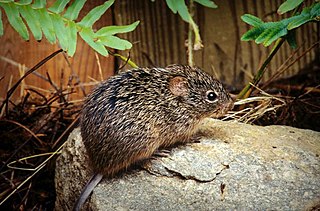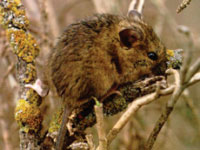
Chevrotains, or mouse-deer, are diminutive, even-toed ungulates that make up the family Tragulidae, and are the only living members of the infraorder Tragulina. The 10 extant species are placed in three genera, but several species also are known only from fossils. The extant species are found in forests in South and Southeast Asia; a single species, the water chevrotain, is found in the rainforests of Central and West Africa. In November 2019, conservation scientists announced that they had photographed silver-backed chevrotains in a Vietnamese forest for the first time since the last confirmed sightings in 1990.

Peromyscus is a genus of rodents. They are commonly referred to as deer mice or deermice, not to be confused with the chevrotain or "mouse deer". They are New World mice only distantly related to the common house and laboratory mouse, Mus musculus. From this relative, Peromyscus species are distinguished by relatively larger eyes, and also often two-tone coloring, with darker colors over the dorsum (back), and white abdominal and limb hair-coloring. In reference to the coloring, the word Peromyscus comes from Greek words meaning "booted mouse". They are also accomplished jumpers and runners by comparison to house mice, and their common name of "deer mouse" is in reference to this agility.

The rodent subfamily Sigmodontinae includes New World rats and mice, with at least 376 species. Many authorities include the Neotominae and Tylomyinae as part of a larger definition of Sigmodontinae. When those genera are included, the species count numbers at least 508. Their distribution includes much of the New World, but the genera are predominantly South American, such as brucies. They invaded South America from Central America as part of the Great American Interchange near the end of the Miocene, about 5 million years ago. Sigmodontines proceeded to diversify explosively in the formerly isolated continent. They inhabit many of the same ecological niches that the Murinae occupy in the Old World.

Reithrodontomys is the genus of groove-toothed New World harvest mice.
Habromys is a genus of rodent in the family Cricetidae, found in Mexico and Central America. It contains these species, all but one of which are threatened or endangered, five of them critically so. H. lophurus is near threatened.

Nectomys is a genus of rodent in the tribe Oryzomyini of family Cricetidae. It is closely related to Amphinectomys and was formerly considered congeneric with Sigmodontomys. It consists of five species, which are allopatrically distributed across much of South America: Nectomys grandis in montane Colombia; Nectomys palmipes on Trinidad and in nearby Venezuela, Nectomys apicalis in the western margins of the Amazon biome, Nectomys rattus in much of Amazonia, and Nectomys squamipes in the Atlantic Forest of Brazil. These species are generally semiaquatic, are normally found near water, and are commonly called water rats.
Nectomys rattus, the small-footed bristly mouse, Amazonian nectomys, Amazonian mouse, or common water rat is a species of rodent in the genus Nectomys of family Cricetidae. It is found in Brazil, Colombia, French Guiana, Guyana, Suriname, and Venezuela, where it lives in a variety of habitats including lowland tropical rainforest, cerrado and caatinga. It is mainly found in areas close to water. It was recognized as distinct only in 2000 and its limits with other Nectomys, including Nectomys apicalis and Nectomys squamipes, remain unclear.

The Mexican volcano mouse is a species of rodent in the family Cricetidae endemic to high elevation areas of the Trans-Mexican Volcanic Belt.

The Perote mouse, or Perote deer mouse, is a species of rodent in the family Cricetidae. It is found only in Mexico.
Eva's desert mouse is a species of rodent in the genus Peromyscus of the family Cricetidae found only in the Baja California peninsula of Mexico.
The false canyon mouse or Coronados deer mouse, is a species of rodent in the family Cricetidae. It is known only from Coronados Island, a small island in the Gulf of California, part of Baja California Sur, Mexico. The species is threatened by predation by feral cats, and the IUCN has assessed its conservation status as "critically endangered".
The Mexican water mouse, Mexican fishing mouse or Goodwin's water mouse, is a species of semiaquatic rodent in the family Cricetidae. It has a restricted range in the state of Oaxaca in southern Mexico, Threatened by deforestation and water pollution, it is listed as Endangered by the International Union for Conservation of Nature (IUCN).
Rheomys raptor, also known as the Goldman's water mouse or Goldman's Ichthyomyine, is a species of rodent in the family Cricetidae. This mouse is semiaquatic and its carnivorous diet includes invertebrates. The conservation status of the species is rated as "least concern" because of its sizable population and the presence of several protected areas within its range. However, deforestation and water pollution represent potential threats.
Thomas's water mouse is a species of rodent in the family Cricetidae found in El Salvador, Guatemala, and Mexico at altitudes of 400 to 2700 m. It lives near forest streams and is semiaquatic; its carnivorous diet includes both invertebrates and small vertebrates. The conservation status of the species is rated as "near threatened" because of the small size of its range and the threat of degradation of its habitat, including the water quality of the streams it lives along.
Underwood's water mouse is a species of rodent in the family Cricetidae. It is found in Costa Rican and western Panamanian cloud forest at altitudes from 1500 to 2000 m. This mouse lives near streams in highland forests and is semiaquatic; its carnivorous diet includes invertebrates. Although its range is small, it includes a number of protected areas, and the population appears to be sizable; the IUCN therefore rates the conservation status of the species as "least concern".
Water mouse can refer to several types of not closely related semiaquatic rodents of superfamily Muroidea:






